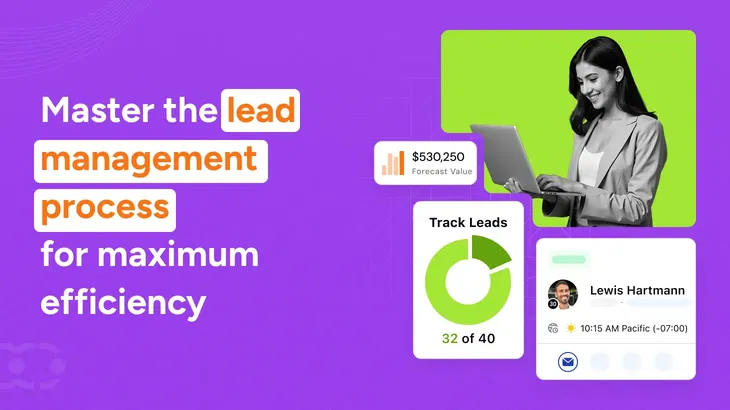Key takeaways
- The lead management process involves capturing, qualifying, nurturing, and converting leads into loyal customers, ensuring efficient tracking and engagement throughout the sales cycle.
- Automating the lead management process with tools like CRM software streamlines tasks such as lead scoring, routing, and nurturing, improving efficiency and conversion rates.
- B2B lead management is unique due to a longer sales cycle, multiple decision-makers, and the need for detailed lead qualification and scoring.
- Tools like CRM software and automation platforms are essential for automating lead capture, nurturing, scoring, and distribution, improving efficiency.
- Tracking metrics such as lead conversion rate, lead response time, and cost per lead helps measure the effectiveness of your lead management process and identify areas for improvement.
Turning leads into loyal customers isn't just a goal. It is the backbone of every successful sales strategy.
The lead management process is the secret sauce that allows businesses to guide qualified leads through the sales cycle and ultimately convert them into paying customers.
By mastering the lead management workflow process, marketing and sales teams can collaborate seamlessly to capture, nurture, and score leads, ensuring that no opportunities are missed.
Whether you’re handling B2B leads or tackling a tricky automotive lead management process, knowing how to manage the flow from lead generation to lead conversion can make all the difference.
Ready to unlock the magic behind an effective lead management strategy?
Let’s dive in and discover how the right lead management tools can transform your sales efforts and turn casual browsers into loyal customers!
What is lead management?
Lead management refers to the process of capturing, tracking, and nurturing leads from initial interest to conversion into paying customers.
It involves stages like lead capture, qualification, nurturing, and conversion. The goal is to ensure that sales teams focus on qualified leads and move them efficiently through the sales funnel.
To manage leads effectively, businesses utilize Customer Relationship Management (CRM) software and lead management tools. These tools help with lead scoring, tracking, and distribution.
Whether it's for B2B leads or automotive lead management, a solid lead management process flow ensures no leads are missed, and both sales and marketing teams work in sync.
Also read: What is lead management? A detailed guide
What makes the B2B lead management process unique?
The B2B lead management process is unique due to its complexity, longer sales cycle, and involvement of multiple decision-makers. Key differences include:
- Longer sales cycle: The sales process is typically longer, with decisions taking months and requiring multiple rounds of approval.
- Multiple decision-makers: B2B sales involve several stakeholders across departments, each with different needs and concerns, requiring tailored communication.
- Advanced lead qualification: Lead qualification is more detailed, often using lead scoring based on factors like company size, revenue, and industry.
- Lead nurturing: B2B lead nurturing focuses on building long-term relationships through personalized communication and relevant content.
- Targeted lead generation: B2B lead generation is highly targeted, focusing on key decision-makers within specific industries or organizations.
Overall, the B2B lead management process emphasizes a more strategic and multifaceted approach to converting leads into customers.
Master your B2B lead management process!
Streamline your sales cycle, engage multiple decision-makers, and boost conversions with a tailored lead management system.
Key benefits of a well-defined lead management process
A well-defined lead management process offers several key benefits that can significantly enhance a business's sales and marketing efforts.
1. Streamlined sales process
A well-defined lead management process ensures that every lead is tracked correctly and guided through the stages of the sales cycle. This clarity enables sales teams to focus on high-priority, qualified leads, thereby improving conversion efficiency.
By having a structured process, leads move seamlessly from lead generation to lead nurturing, maximizing the chances of closing deals.
2. Improved lead tracking
Utilizing the best lead management software or a CRM lead management process makes it easier to track and monitor leads at every stage of the sales cycle.
This visibility helps identify which leads are engaging and which are slipping through the cracks. By tracking leads more effectively, teams can make informed decisions on when to follow up and how to nurture the relationship for better results.
3. Better lead distribution
A well-organized lead management process enables businesses to distribute sales-qualified leads (SQLs) to the appropriate sales representatives based on specific criteria, such as geography or lead interest.
This targeted approach ensures that sales reps engage with leads who are most likely to convert, speeding up the sales process and improving conversion rates.
Related read: MQL Vs. SQL Vs. PQL: What's the difference?
4. Enhanced lead nurturing
With a clear lead management strategy, businesses can deliver the right message to the right potential customers at the right time.
By providing relevant content that aligns with a lead’s interests and pain points, you can guide them smoothly through the sales funnel.
This personalized approach builds trust and helps develop a stronger relationship with leads, increasing the likelihood of a successful conversion.
5. Increased collaboration
A defined lead management process flow ensures better alignment between sales and marketing teams. With clear roles and responsibilities, both teams can work together towards a common goal: Converting qualified leads into paying customers.
This collaboration enhances the overall efficiency of lead handling, ensuring that no leads are ignored or mishandled.
6. Higher conversion rates
Focusing on hot leads and marketing-qualified leads (MQLs) helps sales teams prioritize their efforts on the leads most likely to convert.
By ensuring that sales reps engage with the right leads at the right time, businesses can increase their conversion rates. This targeted approach reduces wasted effort and improves overall sales performance.
7. Improved efficiency
Using tools like a lead management process flowchart or a lead management process diagram allows teams to visualize the entire process, making it easier to identify bottlenecks and inefficiencies.
A structured approach reduces confusion and ensures that every step of the process is well-organized, improving overall workflow and team performance.
Stages of the lead management process
The lead management process comprises several crucial stages that enable businesses to capture, nurture, and convert leads into loyal customers.
From lead generation to lead tracking, each stage plays a vital role in ensuring that sales representatives focus on quality leads and effectively move them through the sales cycle.
A well-defined process helps streamline efforts, improve efficiency, and increase conversion rates.
1. Lead generation
The lead management process begins with lead generation, where businesses focus on capturing leads through various channels such as lead magnets, landing pages, and forms.
This stage involves attracting potential leads who have shown interest in your product or service. Marketing and sales efforts work together to generate leads, ensuring that you’re consistently engaging with prospective customers.
2. Lead qualification and segmentation
Once you’ve captured leads, the next step is lead qualification and segmentation. Here, you identify cold leads, warm leads, and quality leads by analyzing their level of interest and engagement.
This stage helps businesses identify which leads are most likely to progress in the buyer's journey. A good lead management process ensures that sales representatives focus on the most qualified leads, ultimately improving the efficiency of the sales funnel.
3. Lead nurturing
Lead nurturing involves building relationships with potential leads who may not yet be ready to make a purchase.
By providing relevant content and continuous engagement, you help nurture potential customers through the buying process. This stage is essential for leads in the early stages of the sales cycle.
An effective lead management process ensures that leads receive the right information at the right time, turning them into more qualified prospects.
4. Lead scoring
In the lead scoring stage, you assign values to leads based on their behavior, engagement, and readiness to make a purchase. Lead scoring helps prioritize warm leads over cold leads.
It’s a vital part of a good lead management process, ensuring that sales representatives focus their efforts on leads with the highest potential to convert.
This stage enables teams to focus on leads that are most likely to progress in the sales process, thereby optimizing sales efforts.
Prioritize leads like a pro!
Automate lead prioritization to maximize efficiency and ensure your sales team focuses on leads that are most likely to convert.
5. Lead distribution
Lead distribution involves assigning leads to the appropriate sales representatives based on specific criteria, such as geographic location, product interest, or lead score.
Using lead routing helps ensure that leads are passed to the right team members at the right time, optimizing the conversion process.
This stage ensures that no lead is ignored or mishandled, helping improve overall sales performance and making the sales process more efficient.
6. Lead conversion
Lead conversion is the stage at which leads are converted into paying customers.
By implementing an effective lead management solution and maintaining strong communication, businesses can ensure that prospective customers progress through the final stages of the sales cycle and ultimately make a purchase.
A well-defined lead management flow at this stage helps facilitate the buying process and maximize the chances of turning potential leads into loyal customers.
7. Lead tracking
The final stage is lead tracking, where businesses monitor and evaluate the progress of leads through each step of the lead management process.
Tracking provides valuable insights into lead behavior and helps companies adjust their strategies to improve conversion rates.
By continuously evaluating lead engagement, companies can optimize their sales cycle, gain a deeper understanding of nurturing potential customers, and refine their overall lead management strategy.
Must read: 9 Best lead tracking software to boost sales in 2025!
How to automate your lead management process with Salesmate?
Automating your lead management process with Salesmate can significantly streamline your sales workflow and enhance efficiency.
Salesmate offers a CRM lead management process that automates key tasks, including lead capture, distribution, and nurturing, allowing sales representatives to focus on engaging with high-quality leads rather than managing manual tasks.
1. Lead capture and segmentation
With Salesmate, you can easily capture leads from various sources such as website forms, emails, or lead magnets.
Once captured, the platform automatically segments potential leads based on specific criteria like location, behavior, or interest.
This automation saves time and ensures that only the most relevant leads are passed to your sales team.
2. Lead scoring and nurturing
Salesmate’s lead management solution includes built-in lead scoring, where each lead is assigned a score based on their activity and engagement. This allows you to prioritize warm leads over cold leads.
The platform also automates lead nurturing by sending personalized emails or content based on the lead’s position in the buyer's journey.
Explore: 12 Best lead scoring tools you must consider in 2025
3. Lead routing and distribution
Salesmate’s automation tools help you efficiently distribute leads across your sales representatives with its lead routing feature.
Whether based on location, lead score, or product interest, Salesmate ensures the right sales reps are assigned the right leads. This reduces the chances of leads falling through the cracks and accelerates the sales cycle.
4. Lead tracking and reporting
With automated lead tracking, Salesmate continuously monitors the progress of each lead through the sales funnel. Real-time updates ensure that your sales team has complete visibility into the current stage of each lead in the sales cycle.
Automated reporting tools provide valuable insights into lead engagement, conversion rates, and overall sales performance, enabling you to make informed, data-driven decisions.
Transform your sales process today!
Experience the power of automation with Salesmate and watch your lead management process run effortlessly. Capture, score, nurture, and convert more leads with ease.
Conclusion
In conclusion, a well-defined lead management process is essential for converting leads into potential customers. By automating key stages, such as lead capture, qualification, and nurturing, businesses can streamline their sales workflow and enhance efficiency.
A clear lead management process flow ensures sales reps focus on quality leads, while collaboration between sales and marketing teams enhances conversions.
Ultimately, an effective lead management system drives better results, boosts sales, and accelerates business growth.
Frequently asked questions
1. What is the process of lead management?
The lead management process involves capturing, tracking, qualifying, nurturing, and converting leads into customers. It begins with lead generation, followed by qualification, nurturing through the sales funnel, and finally conversion, with ongoing tracking and scoring to prioritize the best leads.
2. What is a lead management system?
A lead management system is a software tool that automates the lead management process, helping capture, track, qualify, and convert leads. It includes features such as CRM integration, lead scoring, and analytics to enhance efficiency and conversion rates.
3. What is the lead process flow?
The lead process flow outlines the steps a lead takes from initial interest to conversion, including lead capture, qualification, nurturing, scoring, and distribution to sales reps. It ensures leads are managed efficiently throughout the sales funnel.
4. How can I define qualified leads in my lead management process?
Qualified leads are those that show high potential to convert into customers. They meet specific criteria, including engagement, behavior, and demographics. Sales-qualified leads (SQLs) are ready for direct sales, while marketing-qualified leads (MQLs) require further nurturing.
5. What tools can I use to automate my lead management process flow?
Tools like Salesmate, HubSpot, Salesforce, and Zoho CRM can automate your lead management process. These tools facilitate lead capture, scoring, routing, and nurturing, thereby streamlining the entire workflow.
6. What metrics should I track to measure the success of my lead management process?
Track metrics like lead conversion rate, lead response time, cost per lead (CPL), lead qualification rate, and sales cycle length to measure the effectiveness of your lead management process.






Key takeaways
Turning leads into loyal customers isn't just a goal. It is the backbone of every successful sales strategy.
The lead management process is the secret sauce that allows businesses to guide qualified leads through the sales cycle and ultimately convert them into paying customers.
By mastering the lead management workflow process, marketing and sales teams can collaborate seamlessly to capture, nurture, and score leads, ensuring that no opportunities are missed.
Whether you’re handling B2B leads or tackling a tricky automotive lead management process, knowing how to manage the flow from lead generation to lead conversion can make all the difference.
Ready to unlock the magic behind an effective lead management strategy?
Let’s dive in and discover how the right lead management tools can transform your sales efforts and turn casual browsers into loyal customers!
What is lead management?
Lead management refers to the process of capturing, tracking, and nurturing leads from initial interest to conversion into paying customers.
It involves stages like lead capture, qualification, nurturing, and conversion. The goal is to ensure that sales teams focus on qualified leads and move them efficiently through the sales funnel.
To manage leads effectively, businesses utilize Customer Relationship Management (CRM) software and lead management tools. These tools help with lead scoring, tracking, and distribution.
Whether it's for B2B leads or automotive lead management, a solid lead management process flow ensures no leads are missed, and both sales and marketing teams work in sync.
What makes the B2B lead management process unique?
The B2B lead management process is unique due to its complexity, longer sales cycle, and involvement of multiple decision-makers. Key differences include:
Overall, the B2B lead management process emphasizes a more strategic and multifaceted approach to converting leads into customers.
Master your B2B lead management process!
Streamline your sales cycle, engage multiple decision-makers, and boost conversions with a tailored lead management system.
Key benefits of a well-defined lead management process
A well-defined lead management process offers several key benefits that can significantly enhance a business's sales and marketing efforts.
1. Streamlined sales process
A well-defined lead management process ensures that every lead is tracked correctly and guided through the stages of the sales cycle. This clarity enables sales teams to focus on high-priority, qualified leads, thereby improving conversion efficiency.
By having a structured process, leads move seamlessly from lead generation to lead nurturing, maximizing the chances of closing deals.
2. Improved lead tracking
Utilizing the best lead management software or a CRM lead management process makes it easier to track and monitor leads at every stage of the sales cycle.
This visibility helps identify which leads are engaging and which are slipping through the cracks. By tracking leads more effectively, teams can make informed decisions on when to follow up and how to nurture the relationship for better results.
3. Better lead distribution
A well-organized lead management process enables businesses to distribute sales-qualified leads (SQLs) to the appropriate sales representatives based on specific criteria, such as geography or lead interest.
This targeted approach ensures that sales reps engage with leads who are most likely to convert, speeding up the sales process and improving conversion rates.
4. Enhanced lead nurturing
With a clear lead management strategy, businesses can deliver the right message to the right potential customers at the right time.
By providing relevant content that aligns with a lead’s interests and pain points, you can guide them smoothly through the sales funnel.
This personalized approach builds trust and helps develop a stronger relationship with leads, increasing the likelihood of a successful conversion.
5. Increased collaboration
A defined lead management process flow ensures better alignment between sales and marketing teams. With clear roles and responsibilities, both teams can work together towards a common goal: Converting qualified leads into paying customers.
This collaboration enhances the overall efficiency of lead handling, ensuring that no leads are ignored or mishandled.
6. Higher conversion rates
Focusing on hot leads and marketing-qualified leads (MQLs) helps sales teams prioritize their efforts on the leads most likely to convert.
By ensuring that sales reps engage with the right leads at the right time, businesses can increase their conversion rates. This targeted approach reduces wasted effort and improves overall sales performance.
7. Improved efficiency
Using tools like a lead management process flowchart or a lead management process diagram allows teams to visualize the entire process, making it easier to identify bottlenecks and inefficiencies.
A structured approach reduces confusion and ensures that every step of the process is well-organized, improving overall workflow and team performance.
Stages of the lead management process
The lead management process comprises several crucial stages that enable businesses to capture, nurture, and convert leads into loyal customers.
From lead generation to lead tracking, each stage plays a vital role in ensuring that sales representatives focus on quality leads and effectively move them through the sales cycle.
A well-defined process helps streamline efforts, improve efficiency, and increase conversion rates.
1. Lead generation
The lead management process begins with lead generation, where businesses focus on capturing leads through various channels such as lead magnets, landing pages, and forms.
This stage involves attracting potential leads who have shown interest in your product or service. Marketing and sales efforts work together to generate leads, ensuring that you’re consistently engaging with prospective customers.
2. Lead qualification and segmentation
Once you’ve captured leads, the next step is lead qualification and segmentation. Here, you identify cold leads, warm leads, and quality leads by analyzing their level of interest and engagement.
This stage helps businesses identify which leads are most likely to progress in the buyer's journey. A good lead management process ensures that sales representatives focus on the most qualified leads, ultimately improving the efficiency of the sales funnel.
3. Lead nurturing
Lead nurturing involves building relationships with potential leads who may not yet be ready to make a purchase.
By providing relevant content and continuous engagement, you help nurture potential customers through the buying process. This stage is essential for leads in the early stages of the sales cycle.
An effective lead management process ensures that leads receive the right information at the right time, turning them into more qualified prospects.
4. Lead scoring
In the lead scoring stage, you assign values to leads based on their behavior, engagement, and readiness to make a purchase. Lead scoring helps prioritize warm leads over cold leads.
It’s a vital part of a good lead management process, ensuring that sales representatives focus their efforts on leads with the highest potential to convert.
This stage enables teams to focus on leads that are most likely to progress in the sales process, thereby optimizing sales efforts.
Prioritize leads like a pro!
Automate lead prioritization to maximize efficiency and ensure your sales team focuses on leads that are most likely to convert.
5. Lead distribution
Lead distribution involves assigning leads to the appropriate sales representatives based on specific criteria, such as geographic location, product interest, or lead score.
Using lead routing helps ensure that leads are passed to the right team members at the right time, optimizing the conversion process.
This stage ensures that no lead is ignored or mishandled, helping improve overall sales performance and making the sales process more efficient.
6. Lead conversion
Lead conversion is the stage at which leads are converted into paying customers.
By implementing an effective lead management solution and maintaining strong communication, businesses can ensure that prospective customers progress through the final stages of the sales cycle and ultimately make a purchase.
A well-defined lead management flow at this stage helps facilitate the buying process and maximize the chances of turning potential leads into loyal customers.
7. Lead tracking
The final stage is lead tracking, where businesses monitor and evaluate the progress of leads through each step of the lead management process.
Tracking provides valuable insights into lead behavior and helps companies adjust their strategies to improve conversion rates.
By continuously evaluating lead engagement, companies can optimize their sales cycle, gain a deeper understanding of nurturing potential customers, and refine their overall lead management strategy.
How to automate your lead management process with Salesmate?
Automating your lead management process with Salesmate can significantly streamline your sales workflow and enhance efficiency.
Salesmate offers a CRM lead management process that automates key tasks, including lead capture, distribution, and nurturing, allowing sales representatives to focus on engaging with high-quality leads rather than managing manual tasks.
1. Lead capture and segmentation
With Salesmate, you can easily capture leads from various sources such as website forms, emails, or lead magnets.
Once captured, the platform automatically segments potential leads based on specific criteria like location, behavior, or interest.
This automation saves time and ensures that only the most relevant leads are passed to your sales team.
2. Lead scoring and nurturing
Salesmate’s lead management solution includes built-in lead scoring, where each lead is assigned a score based on their activity and engagement. This allows you to prioritize warm leads over cold leads.
The platform also automates lead nurturing by sending personalized emails or content based on the lead’s position in the buyer's journey.
3. Lead routing and distribution
Salesmate’s automation tools help you efficiently distribute leads across your sales representatives with its lead routing feature.
Whether based on location, lead score, or product interest, Salesmate ensures the right sales reps are assigned the right leads. This reduces the chances of leads falling through the cracks and accelerates the sales cycle.
4. Lead tracking and reporting
With automated lead tracking, Salesmate continuously monitors the progress of each lead through the sales funnel. Real-time updates ensure that your sales team has complete visibility into the current stage of each lead in the sales cycle.
Automated reporting tools provide valuable insights into lead engagement, conversion rates, and overall sales performance, enabling you to make informed, data-driven decisions.
Transform your sales process today!
Experience the power of automation with Salesmate and watch your lead management process run effortlessly. Capture, score, nurture, and convert more leads with ease.
Conclusion
In conclusion, a well-defined lead management process is essential for converting leads into potential customers. By automating key stages, such as lead capture, qualification, and nurturing, businesses can streamline their sales workflow and enhance efficiency.
A clear lead management process flow ensures sales reps focus on quality leads, while collaboration between sales and marketing teams enhances conversions.
Ultimately, an effective lead management system drives better results, boosts sales, and accelerates business growth.
Frequently asked questions
1. What is the process of lead management?
The lead management process involves capturing, tracking, qualifying, nurturing, and converting leads into customers. It begins with lead generation, followed by qualification, nurturing through the sales funnel, and finally conversion, with ongoing tracking and scoring to prioritize the best leads.
2. What is a lead management system?
A lead management system is a software tool that automates the lead management process, helping capture, track, qualify, and convert leads. It includes features such as CRM integration, lead scoring, and analytics to enhance efficiency and conversion rates.
3. What is the lead process flow?
The lead process flow outlines the steps a lead takes from initial interest to conversion, including lead capture, qualification, nurturing, scoring, and distribution to sales reps. It ensures leads are managed efficiently throughout the sales funnel.
4. How can I define qualified leads in my lead management process?
Qualified leads are those that show high potential to convert into customers. They meet specific criteria, including engagement, behavior, and demographics. Sales-qualified leads (SQLs) are ready for direct sales, while marketing-qualified leads (MQLs) require further nurturing.
5. What tools can I use to automate my lead management process flow?
Tools like Salesmate, HubSpot, Salesforce, and Zoho CRM can automate your lead management process. These tools facilitate lead capture, scoring, routing, and nurturing, thereby streamlining the entire workflow.
6. What metrics should I track to measure the success of my lead management process?
Track metrics like lead conversion rate, lead response time, cost per lead (CPL), lead qualification rate, and sales cycle length to measure the effectiveness of your lead management process.
Hinal Tanna
SEO SpecialistHinal Tanna is a SEO strategist and content marketer, currently working with the marketing team of Salesmate. She has a knack for curating content that follows SEO practices and helps businesses create an impactful brand presence. When she's not working, Hinal likes to spend her time exploring new places.